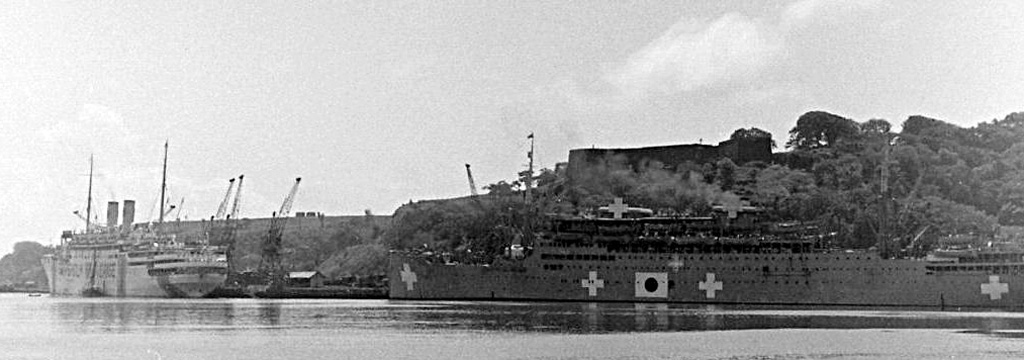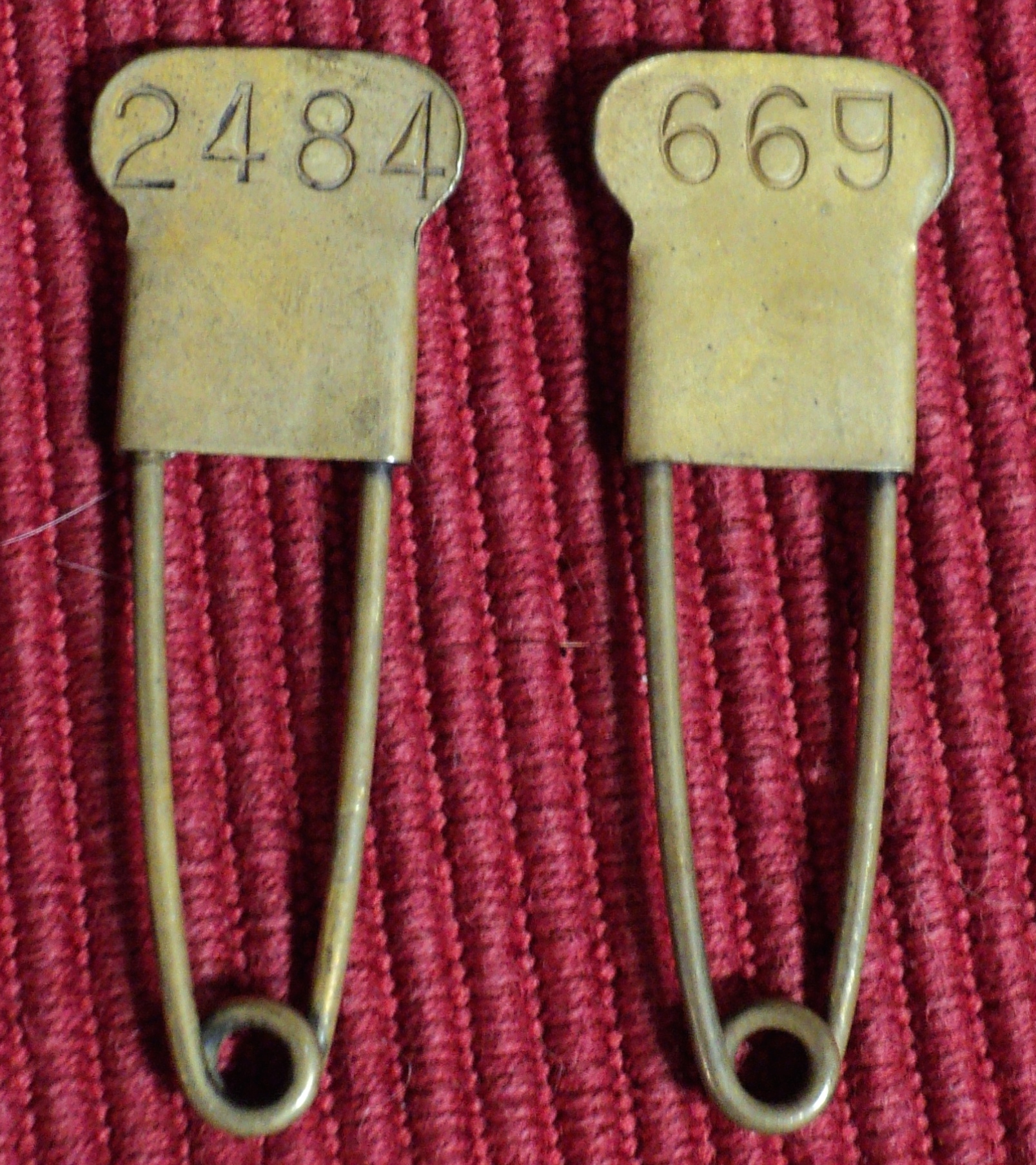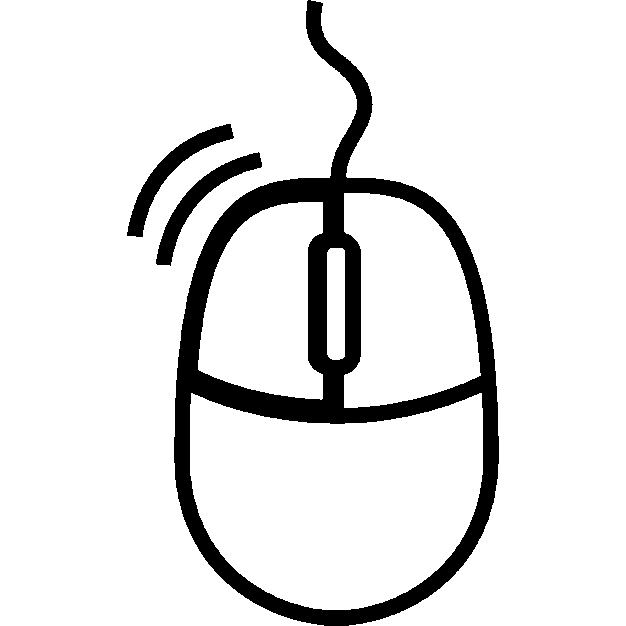prisoner exchange: safety pins ...
the facts: 19 October 1943:
At 0800, the exchange of repatriates begins. Allied repatriates leave from the bow of TEIA MARU and enter GRIPSHOLM via the stern gangway. At the same time, the Japanese leave from the bow of GRIPSHOLM and enter the stern of TEIA MARU. A line of boxcars screens the two lines from each other. The exchange takes 91 minutes. 48,760 Red Cross relief supply parcels for Allied POWS and internees in Singapore, Manila and Japan are transferred GRIPSHOLM and loaded aboard TEIA MARU.

1236 AMERICANS BEING EXCHANGED FOR JAPANESE (newspaper unknown. Washington, Oct 13, [1943] - (/P)
The names of 1236 Americans repatriates from the Far East who are aboard the Japanese exchange liner
Teia Maru en route to Mormugao, Portuguese India, were released tonight by the department of state.
This number does not include an American child born aboard ship, whose name ‘has not yet been reported’.
Among those aboard the ship are the following from Florida: Marguerite Atterbury, Altamonte Springs;
James H.H. Berckman, Lakeland; Helen E.B. Deutsch, Miami; Ruth H. Kunkel, Sarasota; Walter Norman Russell, Jacksonville;
Arthur Wood Turner, West Palm Beach; Titiana Lockaschen Turner, West Palm Beach.
The announcement was made upon receipt of final word from the Swiss government, intermediary in the second such exchange
of nationals with Japan, as to the exact makeup of this list of repatriates, and notification of their next of kin in this country by the
State Department.
Also aboard the Teia Maru, which is now approaching Mormugao, are 221 Canadians and 40 nationals of Latin American
republics who are being repatriated.
A total of 1497 Allied nationals are aboard the Teia Maru.
They will be exchanged probably early next week for an equivalent
number of Japanese nationals who left this country Sept 2 on the Swedish exchange liner, Gripsholm, sailing by way of Rio de
Janeiro, Brazil, and Port Elizabeth, Union of South Africa.
After the Americans and others are exchanged next week for the Japanese, the Gripsholm will bring them back to New York.
The repatriation includes hundreds of American missionaries, plus business personnel of such large American companies as
Socony-Vacuum Oil Company and the National City Bank of New York.
Copy of a newspaper article sent to us by Terri Stewart:
#790 COMES HOME
. Crier (?) Westfield PA Newspaper (part of this name was torn off the article, this was Ruth’s hometown,
Sarasota is her sister’s family and where I live).
The following story contains interesting experiences as told by a former Westfield resident who was released from Japaneseoccupied
China recently.
The returning lady is named Miss Ruth Kunkel, her exchange number is 790, and she comes home to America after six months
in a Jap concentration camp, known as the Weihsien Camp in the Shantung Province. Behind those six months were fifteen years of
serving to China … although Miss Kunkel won’t call them just that. In fact Miss Kunkel feels very strongly about those who patronise
that great land by believing they can be ‘of service’ to it. First, there were many years of teaching at the Peking Medical,
Rockefeller-endowed hospital and college. And then, after her contract with the foundation expired, Ruth just wanted to live on in the
China she had grown to love. So she taught for several years in a boy’s school. “My dear,” her friend remarks, “how in the world
did you ever teach Latin — and to small boys, too!” Ruth smiles… “Oh, I picked it up again. I’d have scrubbed floors to stay on in
Peking!”
The Japanese did not round up every American living in China after Pearl Harbor. Ruth went on living in her home in Peking for
a year and a half. Oh, of course, there were difficulties and annoyances, of a peculiar Japanese nature. She would be visited by the
Jap military, who would gently but politely take anything she possessed which they wanted. There was the day she came home
from work to find her gas stove ‘sealed’ by the invaders. Since the house was cold and she was hungry, she directed her amah to
break the seal.
“I really caught it for doing that. It seems in breaking that seal I had insulted their Emperor to his face. To them that seal is their
Emperor. Oh dear, I had done something terrible.” It is with a sly sense of humour that Ruth references an absurd experience in the
past two years.
She had flaunted a number of Jap edicts for enemy aliens, and they finally decided that they could not allow her to stay in her
home any longer. They were not going to place her in a concentration camp…at least not then…but they were going to put her out
of her house. And so three of them, one from the Army, one from the secret police, and one from the Government, came along one
evening, promptly sealed (that seal again!) the bathroom door, and informed Ruth that she was to leave pronto. Ruth was in
negligee and pointed out that she could not very well leave in such informal dress and that, since her clothing seas in cupboards in
the bathroom, the seal would have to be broken. This seemed logical, even to the Jap, and so the seal was broken and Ruth
allowed to dress. She put on all the clothing she could manage, several dresses, sweaters, coasts, with pockets jammed full of
toilet articles. Her amah meanwhile had grabbed up her two most precious possessions… a flat iron and her ironing board.
Accompanied by the three Japs, Ruth and the amah paraded down the street to a friend’s home (Ruth had asked permission by
telephone to stay the night). The Japs came right in with Ruth, inspected the room she was to occupy, and demanded a cup of tea.
Ruth and her amah served them and, while they drank, Ruth went into another room to rid herself of some of her burdensome
clothing. She heard screams and yells and running feet and hurried back to the Japs. The secret police representative was
indulging in a fine epileptic fit on the floor, and the other two, emitting shrieks of terror, left promptly.
Ruth, her nurse’s training intact, went calmly about the business of bringing the Jap around, and within a few minutes he was
conscious again. He thanked her for helping him, insisted he was all right, and departed. Ruth was settling down for the night
when, with motor horns, sirens, and the usual hubbub of the police, the Japs arrived again. This time Ruth was not to get away
easily. The two Japs who had run screaming from her room had reported her as a murderess bent on poisoning her captors. So
the police arrested Ruth, her amah and, what was worse, the host and hostess. The house was searched for the body of the
victim, and Ruth and her friends were carted off to police headquarters.
Hours of questioning followed, and Ruth thinks she might have ended up in front of a firing squad if the secret policeman had not
at the end of five hours, put in an appearance at the police station where his ‘murderess’ was being questioned. The Japs let Ruth
go. For a few days.
Shortly after that, Ruth departed for the Shantung ‘camp.’ She did not like that departure. “They could have let us out the back
door of the government building right on the station platform. But no. The Japs do not do things that way. Instead we were herded,
like cattle, down the main street of Peking.”
After endless and disheartening train rides, with long delays while track that guerrillas had bombed was repaired, while troop
trains went ahead, the prisoners arrived at their ‘camp,’ and abandoned twice-looted Missionary school, merely a gutted building
offering the minimum of shelter. For weeks, the new occupants sleep on the floor at night, while they cleaned and scrubbed their
quarters by day. The filth had been such that they preferred to sleep on the floor rather than bring their precious beds (the Japs
had allowed them to bring their own) into premises so dirty. The camp divided off into clean-up squads. Amateur plumbers repaired
the pipes and succeeded in bringing water into the camp. Ruth was assigned to the hospital squad and, after a month with no
assistance from the Japs, an infirmary was really working.
All of Ruth’s story of the months spent in camp are of the same pattern. The Japs were not actively cruel…they merely failed to
provide anything save minimum amount of shelter and food. There were no drugs, no bandages, no medical supplies save those
prisoners brought with them. Food consisted mostly of whole wheat bread served up in varied fashion for three meals per day.
Occasionally there would be ... (part of this sentence is missing) ... that an of open wound could become dangerously ill if a thriving
black market had not existed. “It is wonderful what people can do when they have to. We had an exchange store run by one of the
smartest business women in the East. Swaps were arranged and the best I heard of was a fur coat for a pot of jam! Of course, that
was a fair bargain, because you can’t imagine how we craved sugar!”
 Release came to many, including Ruth, when the Swiss Red Cross arranged for a second exchange of prisoners with the Japs.
Ruth became number 790 and started the long voyage home … the endless train trips again, huddled three days and four nights in
crowded third-class carriages (they were not allowed to get off the train, even during long delays), and after days and nights of this
everyone’s feet and legs were so swollen that they could scarcely hobble when they finally reached Shanghai. The Japs had taken
all money from the prisoners when they entered camp, assuring them that it would be held for them until their release. Strangely
enough in this instance, the Japs kept their word, and the prisoners received their money before boarding the Jap freighter Teia
Maru to be carried to the Gripsholm.
Release came to many, including Ruth, when the Swiss Red Cross arranged for a second exchange of prisoners with the Japs.
Ruth became number 790 and started the long voyage home … the endless train trips again, huddled three days and four nights in
crowded third-class carriages (they were not allowed to get off the train, even during long delays), and after days and nights of this
everyone’s feet and legs were so swollen that they could scarcely hobble when they finally reached Shanghai. The Japs had taken
all money from the prisoners when they entered camp, assuring them that it would be held for them until their release. Strangely
enough in this instance, the Japs kept their word, and the prisoners received their money before boarding the Jap freighter Teia
Maru to be carried to the Gripsholm.
 A month of horror was spent on the Jap boat before the prisoners finally met the Swedish ship in the harbour of Mormugao. The
women were herded together in tiny staterooms…thirty-seven in a room sixteen by twenty. The men were placed in the filthy hold.
The food was, if anything, worse than at camp.
A month of horror was spent on the Jap boat before the prisoners finally met the Swedish ship in the harbour of Mormugao. The
women were herded together in tiny staterooms…thirty-seven in a room sixteen by twenty. The men were placed in the filthy hold.
The food was, if anything, worse than at camp.
Ruth looked in vain for the No. 790 alien who had been exchanged for her. As the Gripsholm and the Jap boat met, the
Americans were able to talk with the Japs they were being exchanged for. “A pretty sad and sorry-looking lot, they were too. I don’t
think they looked forward to going home somehow!”
In none of Ruth’s story is there that flagrant horror and cruelty that you’ve been led to expect from the Japs…no torture, no rape.
But when you hear Ruth tell this, you understand the complete, implacable hatred and contempt that the Chinese and those who
have lived in China have for what they call the “monkey people.” Ruth’s faith that it won’t be too long before she’ll be returning to
the China she loves.

- © Copyright by Club Dial, White Plains NY.
#
If you open Greg Leck's excellent book: "CAPTIVES OF EMPIRE" at page: 284 "Repatriation" the historian mentions that the selected people for evacuation on the Japanese ships were marked with white or red ribbons. Red for the officials and white for the civilians.
At another page: 290, for the evacuation on board "Tatua Maru", - another ship - the repatriates were given rosettes to wear in their lapels. This seems to be the case in the above written texts ...
Leopold
#




